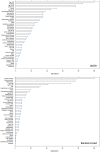Machine learning prediction for mortality of patients diagnosed with COVID-19: a nationwide Korean cohort study
- PMID: 33127965
- PMCID: PMC7599238
- DOI: 10.1038/s41598-020-75767-2
Machine learning prediction for mortality of patients diagnosed with COVID-19: a nationwide Korean cohort study
Abstract
The rapid spread of COVID-19 has resulted in the shortage of medical resources, which necessitates accurate prognosis prediction to triage patients effectively. This study used the nationwide cohort of South Korea to develop a machine learning model to predict prognosis based on sociodemographic and medical information. Of 10,237 COVID-19 patients, 228 (2.2%) died, 7772 (75.9%) recovered, and 2237 (21.9%) were still in isolation or being treated at the last follow-up (April 16, 2020). The Cox proportional hazards regression analysis revealed that age > 70, male sex, moderate or severe disability, the presence of symptoms, nursing home residence, and comorbidities of diabetes mellitus (DM), chronic lung disease, or asthma were significantly associated with increased risk of mortality (p ≤ 0.047). For machine learning, the least absolute shrinkage and selection operator (LASSO), linear support vector machine (SVM), SVM with radial basis function kernel, random forest (RF), and k-nearest neighbors were tested. In prediction of mortality, LASSO and linear SVM demonstrated high sensitivities (90.7% [95% confidence interval: 83.3, 97.3] and 92.0% [85.9, 98.1], respectively) and specificities (91.4% [90.3, 92.5] and 91.8%, [90.7, 92.9], respectively) while maintaining high specificities > 90%, as well as high area under the receiver operating characteristics curves (0.963 [0.946, 0.979] and 0.962 [0.945, 0.979], respectively). The most significant predictors for LASSO included old age and preexisting DM or cancer; for RF they were old age, infection route (cluster infection or infection from personal contact), and underlying hypertension. The proposed prediction model may be helpful for the quick triage of patients without having to wait for the results of additional tests such as laboratory or radiologic studies, during a pandemic when limited medical resources must be wisely allocated without hesitation.
Conflict of interest statement
The authors declare no competing interests.
Figures




Similar articles
-
The Clinical Characteristics and Outcomes of Patients with Moderate-to-Severe Coronavirus Disease 2019 Infection and Diabetes in Daegu, South Korea.Diabetes Metab J. 2020 Aug;44(4):602-613. doi: 10.4093/dmj.2020.0146. Epub 2020 Aug 12. Diabetes Metab J. 2020. PMID: 32794386 Free PMC article.
-
Development and validation of prognosis model of mortality risk in patients with COVID-19.Epidemiol Infect. 2020 Aug 4;148:e168. doi: 10.1017/S0950268820001727. Epidemiol Infect. 2020. PMID: 32746957 Free PMC article.
-
Development of a clinical decision support system for severity risk prediction and triage of COVID-19 patients at hospital admission: an international multicentre study.Eur Respir J. 2020 Aug 20;56(2):2001104. doi: 10.1183/13993003.01104-2020. Print 2020 Aug. Eur Respir J. 2020. PMID: 32616597 Free PMC article.
-
Fasting Plasma Glucose Level Independently Predicts the Mortality of Patients with Coronavirus Disease 2019 Infection: A Multicenter, Retrospective Cohort Study.Endocrinol Metab (Seoul). 2020 Sep;35(3):595-601. doi: 10.3803/EnM.2020.719. Epub 2020 Aug 26. Endocrinol Metab (Seoul). 2020. PMID: 32842719 Free PMC article.
-
Machine learning based early warning system enables accurate mortality risk prediction for COVID-19.Nat Commun. 2020 Oct 6;11(1):5033. doi: 10.1038/s41467-020-18684-2. Nat Commun. 2020. PMID: 33024092 Free PMC article.
Cited by
-
Methodological Considerations on COVID-19 Mortality in Cancer Patients: A Systematic Review and Meta-Analysis.JNCI Cancer Spectr. 2022 Sep 1;6(5):pkac063. doi: 10.1093/jncics/pkac063. JNCI Cancer Spectr. 2022. PMID: 36047915 Free PMC article.
-
Predicting in-Hospital Mortality of Patients with COVID-19 Using Machine Learning Techniques.J Pers Med. 2021 Apr 24;11(5):343. doi: 10.3390/jpm11050343. J Pers Med. 2021. PMID: 33923332 Free PMC article.
-
Applications of artificial intelligence in battling against covid-19: A literature review.Chaos Solitons Fractals. 2021 Jan;142:110338. doi: 10.1016/j.chaos.2020.110338. Epub 2020 Oct 3. Chaos Solitons Fractals. 2021. PMID: 33041533 Free PMC article. Review.
-
An Unsupervised Machine Learning Clustering and Prediction of Differential Clinical Phenotypes of COVID-19 Patients Based on Blood Tests-A Hong Kong Population Study.Front Med (Lausanne). 2022 Feb 24;8:764934. doi: 10.3389/fmed.2021.764934. eCollection 2021. Front Med (Lausanne). 2022. PMID: 35284429 Free PMC article.
-
The accuracy of artificial intelligence in predicting COVID-19 patient mortality: a systematic review and meta-analysis.BMC Med Inform Decis Mak. 2023 Aug 9;23(1):155. doi: 10.1186/s12911-023-02256-7. BMC Med Inform Decis Mak. 2023. PMID: 37559062 Free PMC article.
References
-
- World Health Organization. Coronavirus disease (COVID-19) pandemic.https://www.who.int/emergencies/diseases/novel-coronavirus-2019 (2020)
-
- World Health Organization. Middle East respiratory syndrome coronavirus (MERS-CoV).https://www.who.int/emergencies/mers-cov (2020).
-
- World Health Organization. Cumulative Number of Reported Probable Cases of SARS.https://www.who.int/csr/sars/country/2003_07_11 (2020).
-
- Worldometer. COVID-19 Coronavirus Pandemichttps://www.worldometers.info/coronavirus (2020).
Publication types
MeSH terms
LinkOut - more resources
Full Text Sources
Miscellaneous

